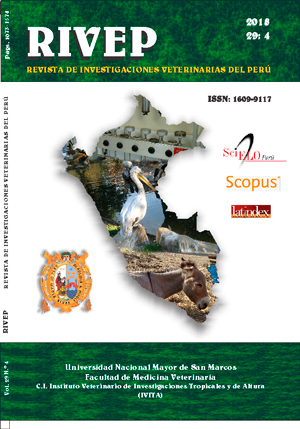Ultrasound parameters of the abdominal organs of tamandua (Tamandua tetradactyla)
DOI:
https://doi.org/10.15381/rivep.v29i4.15305Keywords:
ultrasound, Xenarthra, Tamandua tetradactyla, abdominal organsAbstract
Tamandua (Tamandua tetradactyla) is a mammal that belongs to the superorder Xenarthra, family Myrmecophagidae, lonely animal with crepuscular habits. The objective of the study was to describe the topography, morphology, and location of the abdominal organs through an ultrasound evaluation. Five specimens of T. tetradactyla in captivity from the Huachipa Zoological Park, Lima, Peru (three adult males and two juveniles), in apparent good health conditions were used. A Pie Medical Ultrasound Falco Vet® Model 100 with a multifrequency convex transducer of 5-7.5 MHz was used. The topography, margins, shape, dimensions, echotexture and echogenicity of the abdominal organs were evaluated. The results did not differ from those found in dogs of the same size and weight. However, it has been found that the tamandua, like the Hoffmann's two-toed sloth lazy bear (Choloepus hoffmanni), has intra-abdominal testicles and the kidneys located between the flank and inguinal regions.Downloads
Downloads
Published
Issue
Section
License
Copyright (c) 2018 Jenny Dupont T., Ricardo Grandez R., Catalina Hermoza G.

This work is licensed under a Creative Commons Attribution-NonCommercial-ShareAlike 4.0 International License.
AUTHORS RETAIN THEIR RIGHTS:
a. Authors retain their trade mark rights and patent, and also on any process or procedure described in the article.
b. Authors retain their right to share, copy, distribute, perform and publicly communicate their article (eg, to place their article in an institutional repository or publish it in a book), with an acknowledgment of its initial publication in the Revista de Investigaciones Veterinarias del Perú (RIVEP).
c. Authors retain theirs right to make a subsequent publication of their work, to use the article or any part thereof (eg a compilation of his papers, lecture notes, thesis, or a book), always indicating the source of publication (the originator of the work, journal, volume, number and date).










